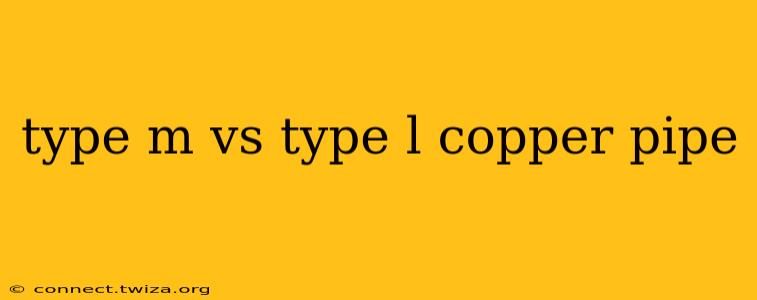Choosing the right copper pipe for your plumbing project is crucial for ensuring longevity, durability, and safety. Two common types, Type M and Type L, often leave homeowners and plumbers questioning their differences. This comprehensive guide will delve into the specifics of Type M and Type L copper pipes, highlighting their key distinctions to help you make an informed decision.
What is Type M Copper Pipe?
Type M copper pipe is a more economical option compared to Type L. It boasts a thinner wall thickness, making it easier to bend and work with. This characteristic makes it a popular choice for many residential plumbing applications where pressure demands are less stringent. Its lighter weight also translates to easier handling and transportation, potentially reducing labor costs. However, this thinner wall comes at the cost of reduced pressure resistance.
What is Type L Copper Pipe?
Type L copper pipe features a thicker wall than Type M, offering superior strength and pressure resistance. This makes it ideal for applications requiring higher water pressure or those subject to significant pressure fluctuations, such as high-rise buildings or areas with high water pressure. While more expensive and slightly more challenging to bend, the added durability and reliability often make it the preferred choice for long-term installations.
Type M vs. Type L Copper Pipe: Key Differences
Here's a table summarizing the key differences between Type M and Type L copper pipes:
| Feature | Type M Copper Pipe | Type L Copper Pipe |
|---|---|---|
| Wall Thickness | Thinner | Thicker |
| Pressure Rating | Lower | Higher |
| Cost | Less Expensive | More Expensive |
| Bendability | Easier to bend | More difficult to bend |
| Applications | Residential, low-pressure systems | High-rise buildings, high-pressure systems |
| Durability | Less durable | More durable |
What are the typical applications for each type?
Type M Copper Pipe: Type M is often used in residential plumbing systems for applications like supplying water to sinks, toilets, and bathtubs. Its lower cost and ease of installation make it attractive for these less demanding applications.
Type L Copper Pipe: Type L is the go-to choice for applications that demand higher pressure resistance, such as main water lines, high-rise buildings, and industrial settings. Its thicker walls ensure longevity and reliability in demanding environments.
Which type of copper pipe should I choose?
The best choice between Type M and Type L copper pipe depends heavily on the specific requirements of your plumbing project. Consider these factors:
- Water pressure: High-pressure systems necessitate the stronger Type L pipe.
- Budget: Type M is the more budget-friendly option.
- Application: Residential applications generally suffice with Type M, while commercial or high-pressure systems require Type L.
- Local plumbing codes: Always check your local building codes for specific requirements and recommendations.
What are the advantages and disadvantages of each?
Type M Advantages: Lower cost, easier to work with, lighter weight.
Type M Disadvantages: Lower pressure rating, less durable.
Type L Advantages: Higher pressure rating, more durable, suitable for high-pressure systems.
Type L Disadvantages: Higher cost, more challenging to bend.
Can I use Type M in place of Type L?
Generally, no. Using Type M where Type L is required is not recommended and may violate building codes. The lower pressure rating of Type M could lead to leaks or failures under higher pressure, potentially causing significant damage. Always select the pipe type appropriate for the intended application and pressure requirements.
By carefully considering the factors outlined above, you can confidently select the right type of copper pipe for your plumbing needs, ensuring a safe, reliable, and long-lasting installation. Remember to consult with a qualified plumber if you have any doubts or require professional assistance.
